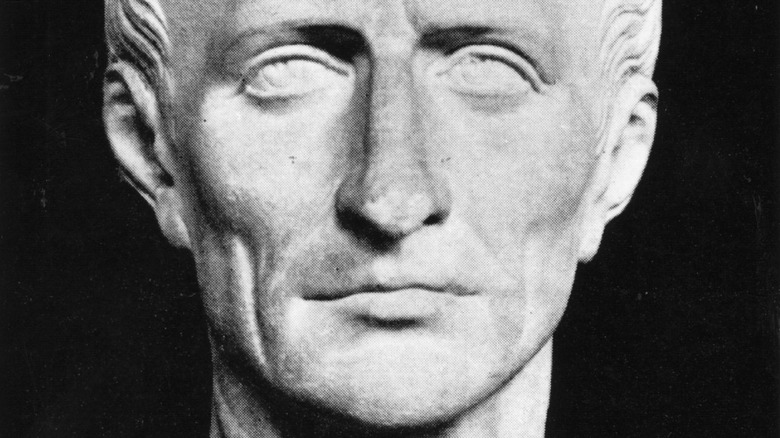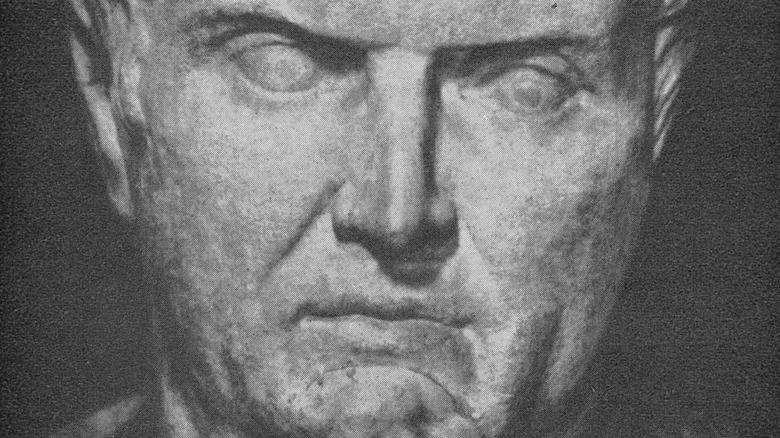The Truth About Cleopatra's Power Struggle
There have been many stories of power struggles throughout history. These behind-the-scenes struggles — some, right in front of everyone — have helped form the fate of entire empires and countries. Few of them are as fascinating as that of Cleopatra, known as Cleopatra VII, who lived from 69-30 B.C., the last pharaoh of Egypt. Her tale was so compelling that William Shakespeare himself mined it for dramatic effect.
Cleopatra lived during a time when men were largely the face of the Egyptian pharaohs, but there were also women who held the reins of power. They included Nefertiti, Hatshepsut, and Merneith. But none of those women would wind up being portrayed by Elizabeth Taylor centuries later. Cleopatra was a compelling figure who apparently was beguiling in her beauty, but also markedly intelligent — for instance, it's reported that she was capable of speaking several languages. She gained the Egyptian throne when she was 18, per Biography, and had no intention of ever losing it. This led to internal strife.
Ultimately, in the midst of these power struggles, Cleopatra become the lover of not one but two Roman rulers and bore their children. This did not end well.
Julius Caesar was one of Cleopatra's lovers
Cleopatra encountered her first power struggle soon after taking the throne. Advisors to her brother, Ptolemy XIII, with whom she shared the reins, undercut her and she had to flee to Syria to save her life (via History). After a year, she marshaled forces and fought Ptolemy's army at Pelesium. It was civil war, and she needed the help of Julius Caesar of Rome (above) to regain power. It was a mutually beneficial relationship, since Caesar wanted to return to power in Rome. Ultimately, they were successful, and as a result, they became lovers. She bore him a son named Caesarion — Little Caesar.
Caesar returned to Rome, where he was assassinated on the Ides of March in 44 B.C. That set off a another power struggle, with Marc Antony, Octavian, and Lepidus going up against the assassins who killed Caesar. Cleopatra received entreaties for Egyptian support from both sides, and after some deliberation, she elected to send forces to help out Marc Anthony. As a result, Mark Antony and Octavian took over as rulers of Rome. It was here that Cleopatra and Mark Antony entered a relationship that would be worthy of that Shakespearean tragedy.
Mark Antony and Cleopatra each met early ends
Meanwhile, Cleopatra was having a tough time as pharaoh. There was a famine (via History). Mark Antony (above) was not faring much better and he called for Cleopatra to come see him. She did and he was instantly smitten with her. Antony agreed to protect her and keep her in power. He then followed her to Egypt and they wound up having twin children together. Things became even more complicated. Antony had to marry Octavian's sister, to keep Octavian placated. He still saw Cleopatra; she helped fund his military campaigns. She had another son by him. Then he scorned Octavia, his wife, which angered Octavian, who went after Cleopatra and the Egyptian army.
Eventually, Octavian's army defeated Cleopatra's forces, and the news emerged that she had taken her own life. Grief-stricken at the news that Cleopatra had killed herself, Antony also committed suicide by throwing himself on his own sword. In something straight out of "Romeo and Juliet," it turned out that she had not committed suicide after all. Sadly, Antony learned this as he was dying. Then Cleopatra did take her own life; legend has it that she died from the bite of an asp. She was 39 when she died.
With her death and the subsequent execution of Caesarion, who was next in line, the lineage of pharaohs was no more. Egypt lost its standing as a world power. But the tragic tale still resonates through history.
If you or anyone you know is having suicidal thoughts, please call the National Suicide Prevention Lifeline at 1-800-273-TALK (8255).


